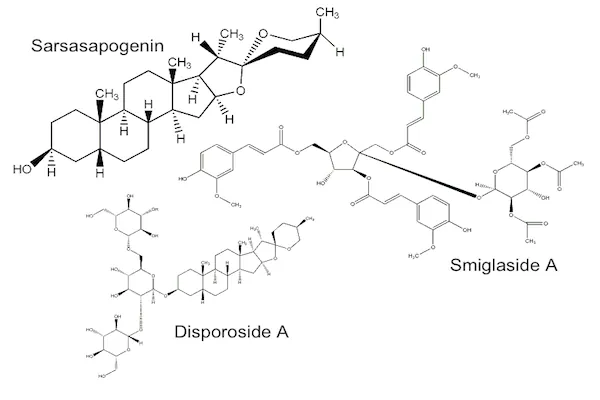Overview of Sarsaparilla
Scientific Name: Smilax
Order: Santalales
Family: Olacaceae
Do not confuse with Indian sarsaparilla (Hemidesmus indices). The rhizomes (modified stems) of Smilax species are used to flavor beverages and for medicine. Soft drinks, called sarsaparilla, are generally made from the roots of Smilax regelii.
Strong:
insufficient informationGood:
insufficient informationPromising:
insufficient informationConflicting (Unclear):
insufficient informationLimited Evidence:
- Gout, a tablet containing sarsaparilla / ash bark [1]
No Evidence:
insufficient informationNo Clinical Research:
All other conditions.- Asthma (caused by inhaling the root dust)
- Diarrhea
- Gastrointestinal Upset
- Nausea
- Kidney Irritation
- Use caution or contact a licensed healthcare practitioner, if you have kidney problems.
- Sarsaparilla may or may not cause blood cell and kidney damage; though, caution is advised.
- There has been a case of asthma associated with sarsaparilla root dust.
There is not enough research on the use of supplements containing sarsaparilla during pregnancy and breast-feeding, so consult a licensed healthcare practitioner before use or avoid use.
Major:
insufficient informationModerate:
insufficient informationPotential:
- Digoxin
- Diuretics (Water Pills)
- Hypnotic Drugs
Sarsaparilla is not a "drug", so the best doses have not been thoroughly established. Make sure to follow the specific product instructions and take as directed on the label, or consult a licensed healthcare practitioner before use.
1. Ji W, Zhu XX, Tan WF, Lu Y. Effects of Rebixiao granules on blood uric acid in patients with repeatedly attacking acute gouty arthritis. Chin J Integr Med. 2005 Mar;11(1):15-21. 2. DerMarderosian A, Beutler JA. The review of natural products: the most complete source of natural product information. 7th ed. St. Louis, MO, USA: Wolters Kluwer Health; 2012. 3. Fetrow CW, Avila JR. The complete guide to herbal medicines. Spring House, PA, USA: Springhouse Corporation; 2000. 4. Gruenwald J, Brendler T, Jaenicke C, editors. PDR for herbal medicines. 4th ed. Montvale, NJ, USA: Thomson Healthcare; 2007. 5. DerMarderosian A, Beutler JA. The review of natural products: the most complete source of natural product information. 7th ed. St. Louis, MO, USA: Wolters Kluwer Health; 2012. 6. Fetrow CW, Avila JR. The complete guide to herbal medicines. Spring House, PA, USA: Springhouse Corporation; 2000. 7. Gruenwald J, Brendler T, Jaenicke C, editors. PDR for herbal medicines. 4th ed. Montvale, NJ, USA: Thomson Healthcare; 2007. 8. Afendi FM, Okada T, Yamazaki M, Hirai-Morita A, Nakamura Y, Nakamura K, Ikeda S, Takahashi H, Altaf-Ul-Amin M, Darusman LK, Saito K, Kanaya S. KNApSAcK family databases: integrated metabolite-plant species databases for multifaceted plant research. Plant Cell Physiol. 2012 Feb;53(2):e1.

